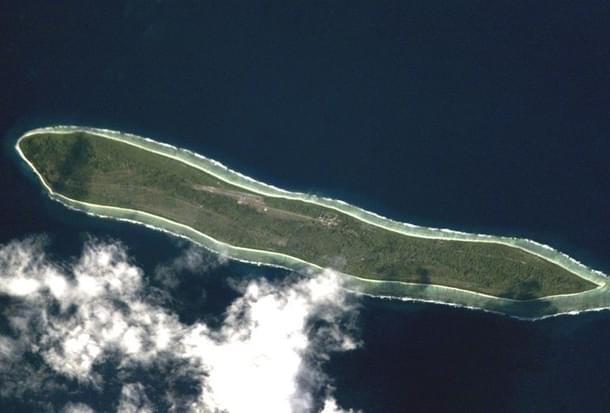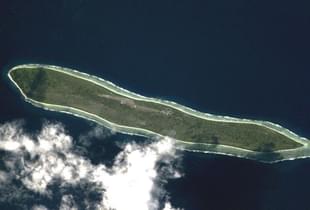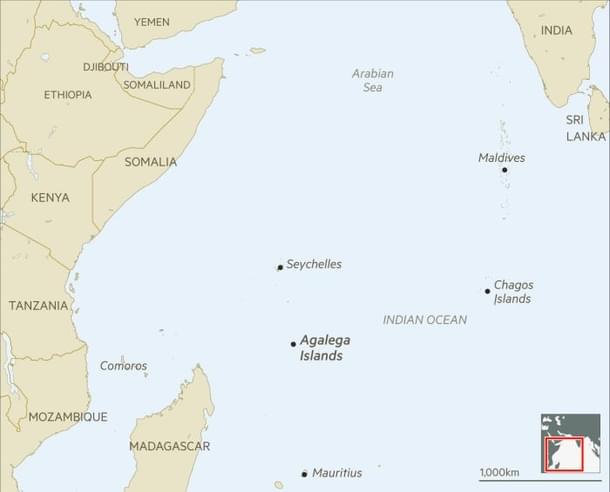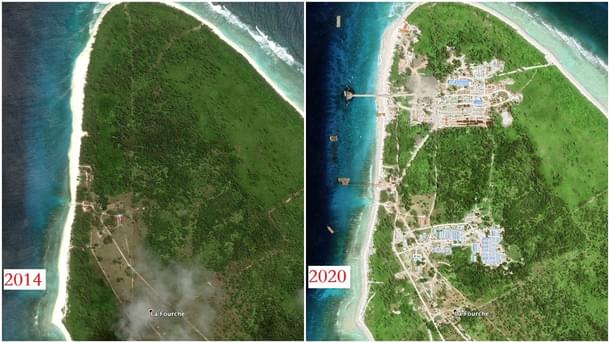Defence
How India’s Military Base On Mauritius’ Agalega Island, Shrouded In Secrecy, Is Taking Shape
Prakhar Gupta
Mar 06, 2021, 12:04 PM | Updated Apr 14, 2021, 12:00 PM IST
Save & read from anywhere!
Bookmark stories for easy access on any device or the Swarajya app.


In 2015, during Prime Minister Narendra Modi’s visit to Mauritius, India had signed an agreement with the remote Indian Ocean island nation for “setting up and upgradation of infrastructure” — a euphemism for a military base — in the country’s Agalega archipelago.
The plan was to build a runway in the middle of the island to facilitate the operations of B737-900 and Airbus 321 type of aircraft, a port near the existing jetty and structures to house communications and intelligence installations, including a transponder system to identify ships as friend or foe.
The project, which was first mooted in 2005 and became a contentious issue in the domestic politics of Mauritius, made little progress in the first few years after the agreement was signed. But sometime in 2018, the Narendra Modi government awarded the project to develop the runway and port infrastructure on the island to India’s Afcons Infrastructure, and work began in 2019.
Six years after India and Mauritius signed the agreement, the base, shrouded in secrecy, is slowly taking shape on the northern of the two Agalega islands, located over 1,100 kilometre north of the main island of Mauritius.
The island sits in the middle of the south-west Indian Ocean, with Seychelles to its north, the Maldives and the US military base in Diego Garcia to its east, and Madagascar and the east coast of Africa to its west.

The latest satellite imagery, shared by Samuel Bashfield, research officer at the Australian National University’s National Security College, in a piece in The Interpreter, a blog run by the Sydney-based Lowy Institute, shows significant progress in the development of the base on the North Agalega island.
The satellite imagery, which appears to be from December 2020, shows that a new 3,000 metre-long runway has come up in the central part of the island, right next to a smaller airstrip, which has existed since the mid-1980s.

The existing runway on the island was in such poor shape that the Dornier 228 aircraft bought from India and operated by the Mauritius Coast Guard was damaged on multiple occasions, while landing and taking off from the island.
The imagery also shows an apron area for aircraft between the new and the existing runway. Some new structures have come up close to the north end of the new runway. Spread over a large area, these structures are most likely meant for military use, like housing personnel on the island in the future.
Port facilities part of the project are coming up in the northern part of the island, close to the small jetty that already existed on the island.

Satellite images show a hive of construction activity in the area near the original jetty, located north-west of the new runway. A large number of buildings, mostly sheds and accommodation for hundreds of Indian construction workers, have come up, in two separate settlements. While some of these buildings could be temporary, a few could be retained for future use.
Apart from the inland structures, satellite imagery from December 2020 also shows two new jetties. These jetties are much longer in comparison to the one that already existed on the island and stretch closer to the deep water.
The Detailed Project Report suggested the creation of jetty infrastructure for berthing and movement of ships of length 149 m and drawing draught of 9 m.
The development of support infrastructure for the base, such as maritime and air traffic control buildings, hangar, passenger terminal for the runway on the island, desalination plant, as well as electricity, water and sewerage systems, will take place over the next few months.
The project remains shrouded in secrecy, with both India and Mauritius keeping the details of the agreement on the base under wraps.
In 2018, the Vice Prime Minister of Mauritius, Fazila Jeewa-Daureeawoo, told the country’s national assembly that the agreement with India was “subject to confidentiality and cannot be disclosed in part or in full”.
In 2017, when he was asked by the Leader of Opposition in the National Assembly if India will base troops at Agalega, Prime Minister Pravind Jugnauth said it will have to “ask for permission from Mauritian authorities”.
The infrastructure coming up at Agalega will support India’s air and surface maritime assets in the western Indian Ocean, including waters close to the southeastern coast of Africa, an increasingly important region where the Indian Navy’s engagements have been relatively limited.
Indian Navy’s long-range maritime surveillance aircraft, P-8Is, will be able to take off from the 3,000 metre-long runway on the island.
India had recently deployed a P-8I in this part of the Indian Ocean for a joint patrol with France from the Reunion Island, located near Mauritius.
India has access to military facilities of Japan, France and the United States — all three have bases in the western Indian Ocean — under the logistics exchange agreements it has signed with these countries.
The facilities in Agalega will support the Indian Navy warships deployed in the western Indian Ocean as the Navy is increasing its presence in the region around Mauritius and Seychelles under its mission based deployments.
India’s Maritime Security Strategy, released in 2015, lists the south-west Indian Ocean, including the Mozambique Channel (the SLOC used by shipping transiting the Cape of Good Hope) and the east coast of Africa, where China has been investing heavily, as one of the primary areas of interest.
The base could also be used for staging Humanitarian Assistance and Disaster Relief operations, which have become an important feature of Indian diplomacy — INS Jalashwa is currently on its way to Madagascar (not far from Mauritius) with assistance to deal with the crisis triggered by a severe drought.
New communications and intelligence infrastructure will come up on the island, improving India’s situational awareness in this part of the Indian Ocean amid increasing Chinese presence, including a base in Djibouti.
Mauritius is already part of India’s maritime domain awareness project with multiple coastal surveillance stations functional throughout the island chain.
With India’s project to develop military and logistics infrastructure on Seychelles’ Assumption Island, located in the south-west Indian Ocean, hitting a roadblock, the base at Agalega has become critical for the Indian Navy’s plan to increase presence and engagement in the western Indian Ocean.
Prakhar Gupta is a senior editor at Swarajya. He tweets @prakharkgupta.





